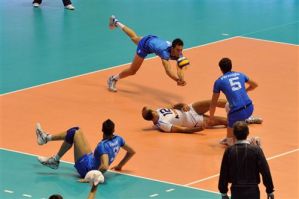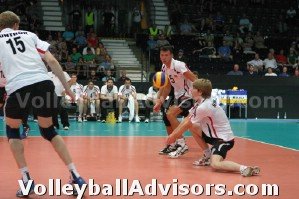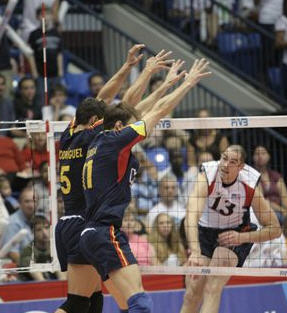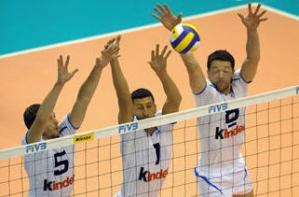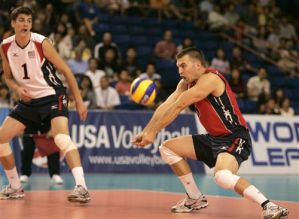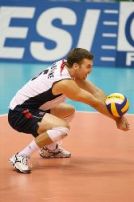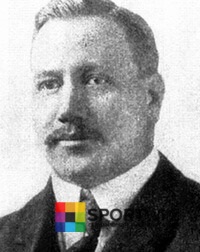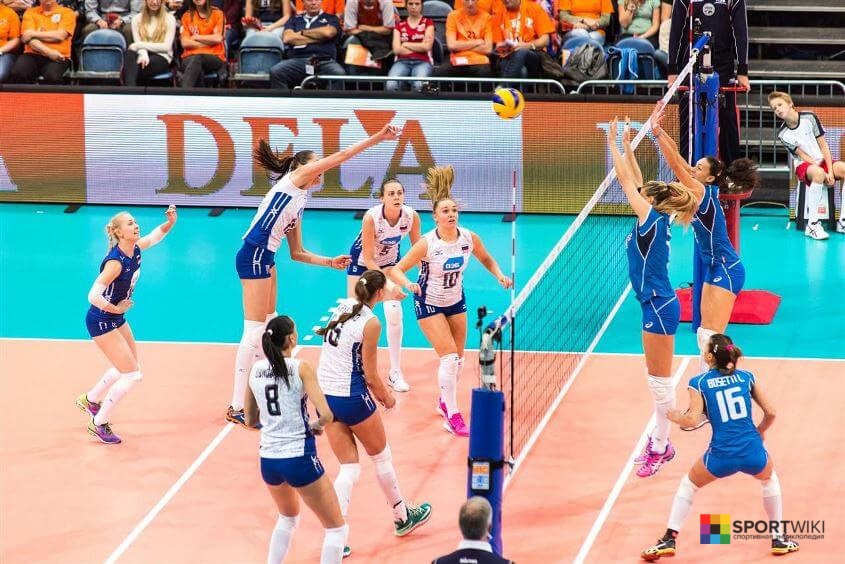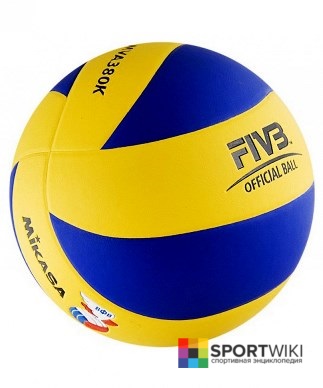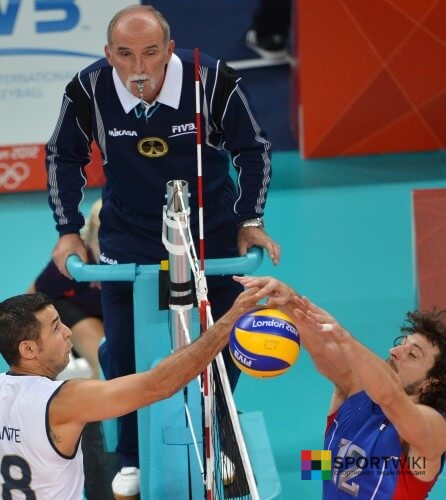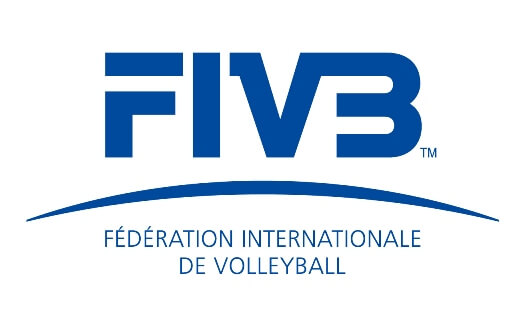Скидка в волейболе на английском
Каталог статей о спорте и здоровом образе жизни
Как найти статью в нашем каталоге:
Англо-русский волейбольный словарь
Предлагаем вашему вниманию краткий англо-русский волейбольный словарь. Здесь даны самые распространенные волейбольные термины и выражения в алфавитном порядке на английском языке с переводом на русский.
illegal substitution – неправомерная замена
incomplete team – неполная команда
individual offense – индивидуальное нападение
individual screen – индивидуальный заслон
individual skills – индивидуальное мастерство
jump training – тренировка прыжка
lose the serve (to) – терять подачу
loss of a point – проигрыш очка
match duration – продолжительность матча
middle back player – центральный игрок задней линии
misconduct – неправомерное поведение, нарушение дисциплины
misconduct penalty – замечание за нарушение дисциплины
pre-season activity – предсезонная подготовка
pre-season competition – предсезонное соревнование
pre-season tournament – предсезонный турнир
preliminary entry – предварительная заявка
preparation period – подготовительный период
psychological preparation – психологическая подготовка
rally – розыгрыш мяча
receiving player – принимающий игрок
receiving team – принимающая команда
tactical pattern – тактическая схема
tactical plan – тактический план
tactical preparation – тактическая подготовка
team action – командное действие
team offense – командное нападение
team play – командная игра
team uniform – командная форма
team mate – партнер, товарищ по команде
technical elements – технические элементы
technical error, fault, foul, mistake- техническая ошибка
technical level – технический уровень
technical skills – технические навыки
technical-tactical preparation – технико-тактическая подготовка
time out request – запрос таймаута
timing – отсчет времени
top player – игрок высшей квалификации
toss up (to) – проводить жеребьевку
touch the net (to) – касаться сетки
training process – тренировочный процесс
tryout – опробование (зала)
two point advantage – преимущество в два очка
underhand pass – передача снизу
underhand serve – подача снизу
universal player – универсальный игрок
unsportsmanlike conduct – неспортивное поведение
venue – место проведения (соревнования)
visiting team – команда гостей
volleyball player – волейболист, волейболистка
warm-up routine – стандартная программа разминки
Basic Descriptions of Volleyball Positions
Rotational six positions of Volleyball
On this page we present volleyball playing positions (libero, outside hitter etc).
If you were looking for rotational positions of volleyball (position 4, position 6 etc) and how players should line up, go to «6 positions of volleyball» page. The link is in the end of this page.
Rotational Volleyball Positions
Basics of volleyball positions on the court
Players have rotational positions (position 5, position 2 etc.) on the court from which they are allowed to move to their playing positions (opposite, middle hitter etc.) after the serve when appropriate.
Volleyball positions on the court can also be called zones. Position 4 being called zone 4 etc.
Playing Positions in Volleyball
Outside Hitter (also called wing spiker, left side)
Outside Hitter is the player who carries the serve receive responsibility along with the libero.
Outside hitter most often attacks the balls which setter sets to the antenna to the left side of the court. 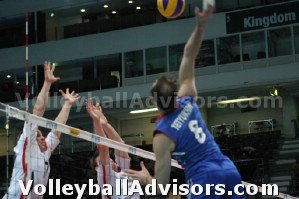
Outside hitters play both the front row and the back row. In modern high level volleyball outside hitters are responsible for hitting the 3 meter or 10 feet line attacks, usually from the middle back position when playing in the back row.
Playing on the outside hitter’s position requires great all around skills because they play through the front row and the back row.
Wing spikers have to have the skills to pass, attack, block, serve and play defense.
Wing spikers along with the opposites are often players who score the most points in the game.
Outside hitter’s passing responsibility makes them extremely important player for the team.
Right side hitter (also called wing spiker)
Right side hitter has the similar role than outside hitter, they play front row and back row and are carrying pass, attack, block, serve and defense responsibilities.
Right side hitters aim to place themselves to the right front playing position.
When playing top level international volleyball on the back court right side hitters often have 3 meter or 10 feet attack responsibility from the middle back position.
Right side hitter can be also called a wing spiker.
Opposite Hitter
The opposite hitter is the player who most often scores the most points in the team.
Opposite hitters don’t have the passing responsibilities. They stand behind the passers on the rotation while libero and outside hitters pass the ball and place themselves to the left front, right front or right back playing position.
The opposite usually get the most sets in the game.
Opposites need to have great blocking skills since they play against the opposite hitter of the opponent or opponent’s outside hitter when in the front row.
Opposites also need to have defensive skills because they also play the back row where they are responsible of hitting 3 meter or 10 feet balls from the right back position.
Setter
The setter is the playmaker, point guard or the quarterback of the volleyball team. 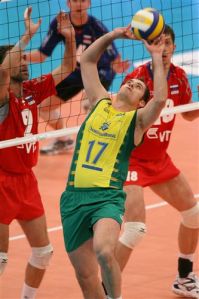
The setter plays both front row and back row, therefore s/he needs to be able to block, serve and play defense.
The setter needs to have good blocking skills because in front row position s/he plays against the opponent’s outside hitter who often carries big load of the attacking responsibility for the team.
The setter plays the right front or the right back position
Middle Blocker (Center, Middle, Middle Hitter)
Middle blockers main responsibility is to stop the opponent’s offense.
The middle blocker builds a block which stops the ball, or allows the team to dig the ball up.
Middle blockers’ job is to stop the opponent’s middle hitters or wing hitters in co-operation with teammates.
Middle blockers need to have great blocking, attacking and serving skills.
Libero
The libero is fairly new position in volleyball. The libero is a back row specialist who is allowed to play back court only.
The libero wears a different color shirt in the team and is allowed to enter and exit the game without substitution request.
The libero can replace any player on the court and most often replaces middle blockers.
The libero is not allowed to serve the ball. (Some leagues in US allow liberos to serve.)
Since playing in the back court only, the libero needs to have the best passing and defensive skills in the team. The libero need to have exceptional serve receive skills because often they pass a larger area than other serve receivers in the team.
Libero most often plays the left back position.
Most leagues in United States allow unlimited substitutions; therefore very often in the team there are defensive specialists.
Defensive specialists in US enter the game to replace players who in international volleyball would be playing both the front and the back row.
Defensive specialists carry a serve receive and defense responsibility in the back row.
Defensive specialists are allowed to serve and often play the full back row rotation before giving the spot in the front row to the offensive player again.
Check out six volleyball positions page to find out how players should line up on the court.
Volleyball
Volleyball is a sports team ball game, the goal of which is to direct the ball towards the opponent, so that it lands on the opponent’s half, or to make the player of the opposing team make a mistake. The players are allowed to touch the ball only three times in a row during one attack.
History of Volleyball
It is assumed that volleyball emerged due to William G. Morgan, a P.E. teacher at one of the colleges in Holyoke (USA). In 1895, at one of his lessons, he hung the net (about 2 meters high) and suggested that his students throw a basketball camera over it. Morgan called this game “Mintonette”.
Two years later, the first volleyball was designed and put into production.
In the second half of the 1920s, National Federations of Bulgaria, the USSR, the USA, and Japan occurred.
In 1922, the first international competitions were held in Brooklyn. It was the YMCA Championship, in which 23 men’s teams participated.
In 1925, the modern dimensions of the court, as well as the size and weight of the volleyball were approved. These rules were relevant to the countries in America, Africa and Europe.
In 1947, the International Volleyball Federation (FIVB) was founded. The following countries became the members of the federation: Belgium, Brazil, Hungary, Egypt, Italy, the Netherlands, Poland, Portugal, Romania, the USA, Uruguay, France, Czechoslovakia, and Yugoslavia.
In 1949, the first men’s world championship took place in Prague, and in 1964 volleyball was included in the program of the Olympic Games in Tokyo. The national teams of the USSR, Czechoslovakia, Poland, Romania, Bulgaria, and Japan achieved the most success in international competitions of the 1960-1970s.
Since the 1990s, Brazil, the USA, Cuba, Italy, the Netherlands, and Yugoslavia have been added to the list of the strongest teams.
Since 2006, FIVB comprises 220 national volleyball federations. The game is one of the most popular sports in the world.
Volleyball rules
A volleyball match consists of sets (from 3 to 5). The duration of the volleyball set is not limited and lasts until one team scores 25 points. If there is less than 2-point lead over the opponent, the set continues until the lead is increased. The match continues until one team wins three sets. It is worth noting that the maximum score in the fifth set is 15 instead of 25 points.
Each of the two teams may have up to 14 players, but there may be 6 players on the floor at the same time.
The ball is introduced into the game by serving, the serving team is chosen by a coin toss. After each transfer of the right to serve from one team to another, the players move through the zones in clockwise order. The ball is served from behind the inline. If the server steps over the line, serves the ball out of the court or hits the net, the team loses the serve and the opponent gets a point. Any player has the right to take the serve; usually, it is a front row player. The serve is not blocked.
The front row player may perform a spike. Such a hit is carried out over the net. Back row players attack from the 3-meter mark.
The attack is blocked over the net so that the ball is prevented from flying over the net. While blocking, the players may put hands to the opponents’ side, without interfering them. Only front row players are blocked.
Volleyball Court
The volleyball court is rectangular in shape and has the following dimensions: it is 18 meters long and 9 meters wide. The net is located in such a way that its highest point is 2.43 meters high above the floor at men’s competitions and 2.24 meters high – at women’s competitions. These dimensions were approved by the International Volleyball Federation in 1925 and are relevant to this day. The playing surface should be horizontal, flat, uniform and light.
There is the concept of a free zone on the volleyball court. The dimensions of the free zone are specified and are as follows: 5-8 meters from the front lines and 3-5 meters from the sidelines. The free space above the court must be 12.5 meters.
The playing court is limited by two side and front lines, which are considered in the court dimensions. The axis of the middle line, drawn between the sidelines, divides the playing space into two equal parts 9 x 9 m. It is drawn under the net and marks off the opponents’ zones. The attack line is drawn on each half of the court three meters behind the middle line.
Volleyball Equipment
The most important attribute of the volleyball match is volleyball. Like any ball, the volleyball is a spherical construction consisting of an internal rubber chamber, which is hidden under natural or synthetic leather. Balls vary based on their purpose (official competitions, training games), age of the participants (adults, juniors) and type of the venue (open, closed).
Volleyball combines elements of jumping and running, so comfortable shoes are an important attribute. Shoes with soft soles are the most suitable for playing volleyball. Sometimes, special insole-shock absorbers are used additionally, they are very efficient in preventing injuries.
Athletes use knee pads and elbow pads for additional protection of joints.
Player specialization
Referees
The match officials are as follows:
Official FIBV competitions require an assistant secretary.
The most large-scale volleyball competitions
The Olympic Games are the most prestigious volleyball competitions.
The World Championship is a competition of the strongest national volleyball teams, which are held once every four years. They are the second most prestigious volleyball competition after the Olympic Games.
The World Cup is an international tournament in men’s and women’s volleyball. It is held a year before the Olympic Games, and its prize-winners are secured to participate in the Olympic Games.
The World Champion Cup. The World Champion Cup is held a year before the year of the World Cup.
FIVB World League is the most prestigious commercial tournament for men’s national volleyball teams.
The Volleyball Grand Prix is the largest commercial tournament for the women’s national volleyball teams.
The European Championship is the competition of the strongest men’s and women’s national volleyball teams of the European Volleyball Confederation. It is held biennially.
Euroleague is an annual competition of national volleyball teams, held under the auspices of the European Volleyball Confederation.
Volleyball sports institutions
The International Volleyball Federation (French — Fédération Internationale de Volleyball, abbr. FIVB) is an international federation that comprises 220 national federations. The headquarters is located in the Swiss city of Lausanne.
The European Volleyball Confederation (French – Confédération Européenne de Volleyball, abbr. CEV) is an institution that controls the European volleyball. It comprises 55 national federations.
The All-Russian Volleyball Federation is an institution that controls Russian volleyball.
2020-10-04 2021-04-06 https://sport-wiki.org/sports/volleyball
The goal of volleyball is to direct the ball towards the opponent, so that it lands on the opponent’s half, or to make the player of the opposing team make a mistake.
Players may not touch the net.
The first four sets are played to 25 points, with the final set being played to 15 points. A team must win a set by two points.
Скидка в волейболе на английском


Откройте возможности нейронного машинного перевода PROMT
PROMT.One (www.translate.ru) – бесплатный онлайн-переводчик на основе нейронных сетей (NMT) для азербайджанского, английского, арабского, греческого, иврита, испанского, итальянского, казахского, китайского, корейского, немецкого, португальского, русского, татарского, турецкого, туркменского, узбекского, украинского, финского, французского, эстонского и японского языков.
Изучайте времена и формы глаголов в английском, немецком, испанском, французском и русском языках в разделе Спряжение и склонение. Учите употребление слов и выражений в разных Контекстах. Мы собрали для вас миллионы примеров перевода на разные языки, которые помогут вам в изучении иностранных языков и подготовке домашних заданий.
Переводите в любом месте и в любое время с помощью мобильного переводчика PROMT.One для iOS и Android. Попробуйте голосовой и фотоперевод, скачайте языковые пакеты для офлайн-перевода.
Поделиться переводом
Но сейчас вы можете переводить только 999 символов за один раз.
Пожалуйста, войдите или зарегистрируйтесь, чтобы переводить до 5 000 символов единовременно. войти / зарегистрироваться
Добавить в избранное
Для добавления в Избранное необходимо авторизоваться
Скидка в волейболе на английском
Взлёт — короткий быстрый пас нападающему в 3-ю зону, который в момент касания мяча связующим уже находится в воздухе с рукой, готовой для нанесения удара.
Второй темп — вариант атаки, при котором связующий подключает диагональных нападающих.
Добить до пола — основная цель игры в волейбол.
Доигровка — продолжение атаки, когда принимающая команда не смогла организовать съём. Продолжительная доигровка характерна для женского волейбола.
Дриблинг — характерное постукивание мяча об пол перед выполнением подачи.
Загнать под кожу — при атакующем ударе нападающего загнать мяч между сеткой и руками блокирующих.
Зачехлить — закрыть атаку соперника блоком.
Зона конфликта — зона ровно посередине между принимающими игроками. Подача в зону конфликта сильно затрудняет приём.
Надеть на уши — игровая ситуация, когда отразившийся от блока мяч ударяется обратно в атакующего. Неприятный для игрока исход атаки.
Организованный блок — правильно построенный сомкнутый групповой блок, закрывающий наиболее вероятное направление удара и создающий максимальные проблемы атакующему.
Отыграться от блока — несильным ударом об край блока отправить мяч в аут или оставить в игре для более успешной доигровки.
Пайп — вариант атаки, когда связующий подключает к атаке игрока из 6-й зоны. При этом атакующий игрок бьёт, отталкиваясь из-за 3-х метровой линии.
Первый темп — вариант атаки, при котором связующий передаёт мяч коротким пасом игроку из третьей зоны.
Переходящий мяч — мяч, перелетающий на сторону противника невысоко над сеткой, позволяющий легко выиграть очко атакой с первого же удара. Обычно возникает при плохом приёме подачи.
Планер — планирующая подача, при которой мяч летит с относительно небольшой скоростью по неустойчивой траектории, при этом может в конце нырнуть.
Позитивный приём — хороший приём подачи, который позволяет связующему выбрать любую задуманную им передачу и комфортно её сыграть.
Сняться — выиграть очко в результате своей атаки после подачи соперника.
Схема 4-2, 5-1, 6-2 — различные тактические схемы игры. Схема 4-2 — четыре нападающих и два связующих в противоположных зонах, передачу отдает тот из них, кто находится на передней линии. Схема 5-1 — пять нападающих и один связующий, выходящий на передачу с передней и с задней линии. Схема 6-2 — четыре нападающих и два связующих, передачу отдает тот из них, кто выходит с задней линии, в то время как связующий на передней линии играет в атаке.
Флот (от английского float) — подача сверху, при которой мяч летит по плоской труднопредсказуемой траектории.
Эйс (от английского en:Ace) — очко, выигранное непосредственно с подачи, когда мяч доведён до пола или произошло только одно касание и мяч ушёл в аут.

